The Similan Islands is where you can enjoy the best scuba diving in Thailand. Located 60 kilometres out into The Andaman Sea off of Thailand’s west coast, the islands are best enjoyed on a liveaboard cruise, but you can also go there on a day trip from Khao Lak. Due to the Indian Ocean monsoon, the islands are closed to the public from mid-May to mid-October, but from October 15th until May 15th you can visit Thailand’s most beautiful underwater oases. Depending on whether you want the best sea conditions, the best weather, the best price, or to visit when the islands have fewer other people, this page explains it all.
When is The Best Time to Dive Similan Islands
The best time to dive Similan islands depends on what is most important to you. Some people are more concerned about the weather between dives, while others worry about waves and just want to get there as smoothly and quickly as they can. And if you’re clever and prepared, you can choose when the currents are likely to be weaker. The water temperature and visibility are pretty consistent throughout the year but they can vary. The national marine park is only open from the middle of October to the middle of May, and this page explains what to expect above and below the surface at The Similans during those months.
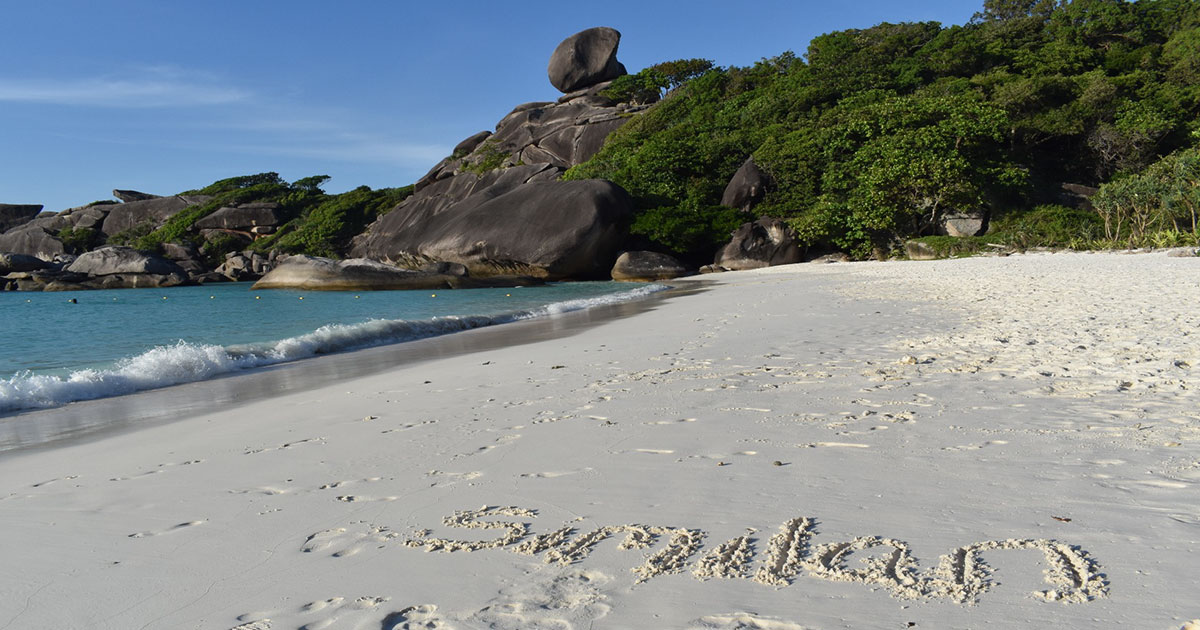
The Weather
The Weather has a great impact on everyone’s ability to enjoy diving at The Similan Islands. Being a tropical zone, there are three seasons each year instead of four. The monsoon season is from June to September on Thailand’s west coast, as this is directly affected by The Indian Ocean, The Bay of Bengal, and The Andaman Sea. February and March are the best months for diving at The Similans regarding to predicted weather. But from early December until late April you can usually expect clear skies nearly all day every day. The weather has almost no effect on life underwater, but divers need to travel out there on boats and will spend more of the trip out of the water than in it. Therefore, the weather at the Similan Islands is an important factor for all divers. And due to the likelihood of extreme weather during the monsoon months, the local authorities close the marine parks from May 16th until October 14th every year. Therefore the Similan diving season is from October 15th to May 15th.
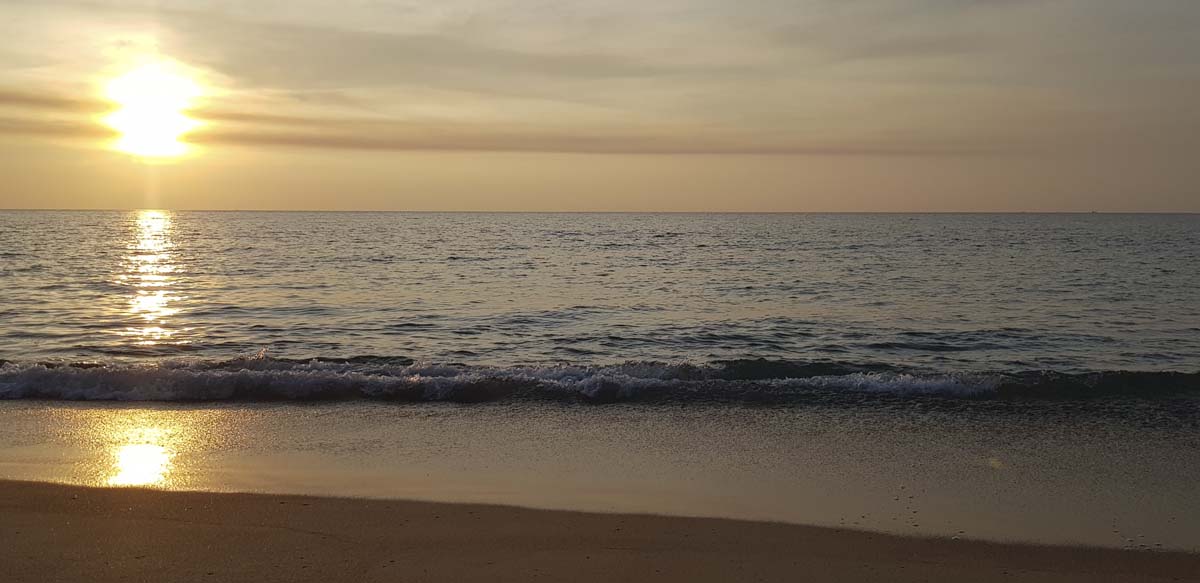
The Waves
 The waves are actually the main reason that the marine parks are closed during the monsoon season. Strong and unpredictable winds coming from The Indian Ocean can cause large waves. Not only is this dangerous for any diving or fishing boats that go out to sea, but it’s also unfair to expect the coast guard to have to sail out in these conditions to rescue those in need.
The waves are actually the main reason that the marine parks are closed during the monsoon season. Strong and unpredictable winds coming from The Indian Ocean can cause large waves. Not only is this dangerous for any diving or fishing boats that go out to sea, but it’s also unfair to expect the coast guard to have to sail out in these conditions to rescue those in need.
During the months from December to late April there are very few days when the waves are too high to enable liveaboard diving boats to sail. From time to time, the boats may need to adjust an itinerary in order to provide safety and comfort for the guests. This can include spending more time in sheltered areas, such as on the eastern side of the Similan Islands or at The Surin Islands. Richelieu Rock is exposed in open sea, and on days when waves are high day trip speedboats might need to cancel or offer a different dive site. And from time to time even scuba liveaboards might have to skip the planned dives at Richelieu Rock if the forecast says that waves are high.
From a guest’s point of view, waves can have a negative effect on their experience. Firstly, crossing from one dive site to the next is slower when the sea is rough. And of course the rocking boat can make things roll around on tables and even cause some passengers to become seasick. Once you’re in the water and diving, the waves have almost no effect on your enjoyment or safety. But when it’s time to get back on the boat, things are much less fun and can even be dangerous. Keep reading to find out all about the water temperature at Thailand’s Similan Islands.
Water Temperature
Water temperature is very important to how much you enjoy your dive and what exposure suit (if any) you bring or rent. It can also affect how long you’re able to stay underwater, because if it’s too cold you might need to end your dive earlier than expected. Choosing the right wetsuit will ensure that you’re comfortable during every dive, and 3mm wetsuits are most common at the Similans. Some divers don’t even wear that, and are happy with a rash guard.
A lot of people think that the sea is a lot colder in winter than it is in the summer, but this isn’t true. You feel the cold more in the winter, especially after you get out of the sea and you’re still wet, but this is because the air is colder not the water. The Similan Islands water temperature remains quite constant throughout the year. The average sea temperature at depths less than 40 metres is 27-29°C all year round. There are times when it drops to the mid or even low 20s, but in general these are rare or temporary occasions. Every four or five years, we experience cooler and greener water at the Similans. More of this is explained further down.
The most-common time when the water temperature drops in tropical seas is when a thermocline passes. These bodies of cooler water rise from the deep, and divers usually see it just before feeling it. There is a distinct difference in density and temperature compared to the regular water. You will see a shimmer where the two different types of water meet, and certainly feel the difference, which can be 4-6°C. Thermoclines usually pass within a few minutes. Don't panic or try to swim away from it. Just hang on and wait it out.
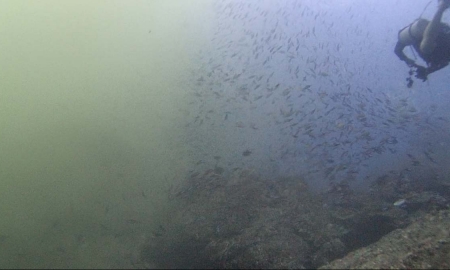 Green Monster approachingIn December 2019, the average Similan Islands water temperature was 23-26°C, and this lasted into early 2020. A similar thing happened in late 2023 and early 2024. During these periods, the visibility was reduced, but many sharks and rays not normally seen were spotted at dive sites across the area. Local guides often refer to this as the 'Green Monster.'
Green Monster approachingIn December 2019, the average Similan Islands water temperature was 23-26°C, and this lasted into early 2020. A similar thing happened in late 2023 and early 2024. During these periods, the visibility was reduced, but many sharks and rays not normally seen were spotted at dive sites across the area. Local guides often refer to this as the 'Green Monster.'
The Green Monster is a term often used by many dive guides at The Similan Islands when they refer to certain underwater sea conditions. As the name suggests, it’s green and something that you want to avoid. The Green Monster is a body of water that moves through The Similans and is considerably cooler than the water surrounding it. Visibility is also greatly reduced. It can come at any time of year or day, and can pass quickly or stay for your whole dive, or even all day.
Even on a dive in the middle of a high season with wonderful sea conditions, the Green Monster can show up. You can usually see it coming, and your dive guide will do his or her best to lead your group away from it, but this isn’t always possible. Depending on the current and the shape & size of the dive site, sometimes the only option is to stay in the Green Monster and hope it passes over after a few minutes. This can happen, but it’s equally likely that the rest of your dive will be inside the cool murky water. It can even last all day, or longer.
But looking on the bright side, this cold green water is really good for marine life. It’s full of nutrient-rich plankton and algae, and brings food for the reef, followed by fish, followed by bigger fish! Although it’s not that much fun to dive in because it’s cold and you can’t see much, there’s more chance of a large filter feeder like a Whale Shark or Manta Ray being not so far away. Our next section explains about underwater currents for diving at The Similan Islands.
Currents
Currents are extremely necessary for a healthy reef, but most divers prefer not to have to swim against them. There are some divers who enjoy fighting or hanging on in a strong current, but the majority of us prefer to save our energy and have more control of where we swim around the reef. Drifting on a current is a nice way to see lots while expending minimal effort, but less-experienced divers may feel nervous of being carried away. The vast majority of recreational divers are happiest when there is no current to affect their dive plan.
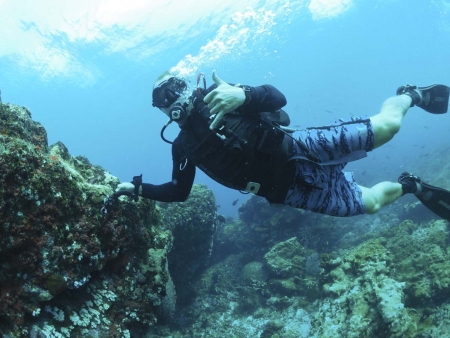 Strong current - credit Johan FolmeusWe are often asked if the currents are strong in low season or during bad weather. But it’s important to remember what creates the currents, which is the moon’s gravity. The moon has a fixed cycle that can be accurately predicted years in advance. Twice each month its pull is strong, and between these times its strength wanes and then increases. This therefore means that the currents are not stronger or weaker during low or high season or affected by the weather. Currents are only affected by the moon.
Strong current - credit Johan FolmeusWe are often asked if the currents are strong in low season or during bad weather. But it’s important to remember what creates the currents, which is the moon’s gravity. The moon has a fixed cycle that can be accurately predicted years in advance. Twice each month its pull is strong, and between these times its strength wanes and then increases. This therefore means that the currents are not stronger or weaker during low or high season or affected by the weather. Currents are only affected by the moon.
All of the tour leaders and dive guides want to have happy guests, and they actually enjoy diving as well. So, to maximise everyone’s enjoyment and dive time, the teams plan the dives to be at the best time and direction in order to avoid or minimise anyone having to fight a current. This can’t always be guaranteed, but our teams always do their best. And it’s important to remember that some dive sites are more prone to currents than others. For example, Koh Tachai is the northernmost point of the Similan Islands National Marine Park. This uninhabited granite island in the Andaman Sea has an extremely-rich ecosystem below the surface. Hard & soft corals, reef fish & invertebrates live there, and pelagic filter feeders visit regularly. Currents at Koh Tachai Pinnacle can be stronger than other Similan dive sites, and they are also unpredictable. And with the shallowest part of the pinnacle being 12 metres deep, getting down to the dive site often needs good timing or use of the mooring line. But once you’re down there, there’s always plenty of shelter provided by the huge granite boulders that make up this dive site. Without currents, Koh Tachai wouldn’t be as wonderful as it is. Read on to learn more about the visibility you can expect when diving at the Similan Islands.
Visibility
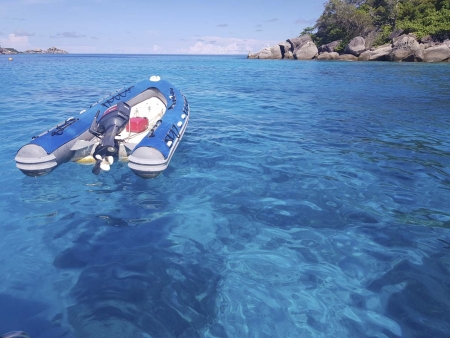 Visibility is a very important factor to maximise your Similan diving enjoyment. Underwater visibility is how far you can see in any direction, and it is usually measured in metres or feet. Less than 10 metres visibility is considered to be low for recreational divers in tropical seas. More than 30 metres’ visibility is extremely good, which is more than from one end of a swimming pool to the other. On average, you can expect 20 metres visibility at The Similan Islands throughout the Thailand diving season. On some days it can drop below 15 metres, and when the Green Monster shows up it comes down to 10 metres or less. In general, the visibility at The Similan Islands doesn’t change much throughout the year. However, if the sky is clear and the weather good, you can expect the light and colour to improve how things look below the surface. Plankton is the main thing that affects visibility, and this is on the move all year round.
Visibility is a very important factor to maximise your Similan diving enjoyment. Underwater visibility is how far you can see in any direction, and it is usually measured in metres or feet. Less than 10 metres visibility is considered to be low for recreational divers in tropical seas. More than 30 metres’ visibility is extremely good, which is more than from one end of a swimming pool to the other. On average, you can expect 20 metres visibility at The Similan Islands throughout the Thailand diving season. On some days it can drop below 15 metres, and when the Green Monster shows up it comes down to 10 metres or less. In general, the visibility at The Similan Islands doesn’t change much throughout the year. However, if the sky is clear and the weather good, you can expect the light and colour to improve how things look below the surface. Plankton is the main thing that affects visibility, and this is on the move all year round.
Dive Sites Have More Boats & Divers
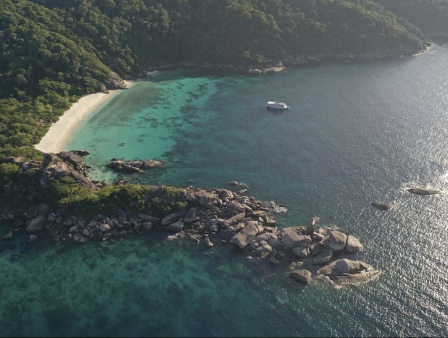 Dive sites have more boats & divers during the busiest periods. The peak season is Christmas & New Year, plus Chinese/Lunar New Year, but for much of January, February and March is the high season at the Similan Islands. You can normally expect there to be other dive boats at most dive sites, especially Richelieu Rock, during this period. Daytrip speedboats arrive at the dive sites at 9.30am, and leave at 3.30pm, meaning that this time of day is even busier than when there are only liveaboard boats out there. In October, early November and after the middle of April, dive sites are quieter, because fewer boats offer trips and those boats that do are rarely fully booked. For less busy dive sites and good diving conditions, we recommend the middle of December and the third week of April. A week before Christmas and the week after Thai New Year are great times to get the best balance of sea & weather conditions and dive sites which are not crowded.
Dive sites have more boats & divers during the busiest periods. The peak season is Christmas & New Year, plus Chinese/Lunar New Year, but for much of January, February and March is the high season at the Similan Islands. You can normally expect there to be other dive boats at most dive sites, especially Richelieu Rock, during this period. Daytrip speedboats arrive at the dive sites at 9.30am, and leave at 3.30pm, meaning that this time of day is even busier than when there are only liveaboard boats out there. In October, early November and after the middle of April, dive sites are quieter, because fewer boats offer trips and those boats that do are rarely fully booked. For less busy dive sites and good diving conditions, we recommend the middle of December and the third week of April. A week before Christmas and the week after Thai New Year are great times to get the best balance of sea & weather conditions and dive sites which are not crowded.
Getting the Best Deal
If getting the best deal is your main criteria for choosing when is the best time to dive Similan Islands then you have plenty of options. It’s even possible to get a discount and dive at the most-popular times. Early-bird discounts are available on some boats and their trips, even for peak periods, but you normally have to be quick to get your cabin confirmed before the trip is fully booked. If you just want the best discount, and you’re flexible on your travel dates, then some boats discount trips for the first and final weeks of the Similan Islands diving season. Last-minute discounts are also available on some boats & trips, but these are normally only for the remaining cabins which might not be your first choice.




Comments
My wife and I will be in Thailand from 9th until 22nd October and we would love to do a 3 day/night liveaboard to dive the Similan Islands.
Do you have any availability that work with these dates and when the National park opens up again?
Thanks
Liam